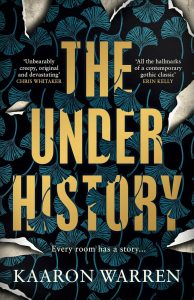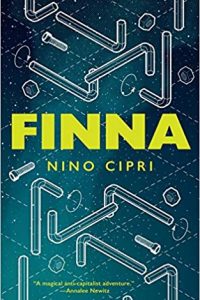Ian Mond Reviews The Underhistory by Kaaron Warren
 The Underhistory, Kaaron Warren (Viper 978-1-80081-202-4, £16.99, 383pp, hc) April 2024.
The Underhistory, Kaaron Warren (Viper 978-1-80081-202-4, £16.99, 383pp, hc) April 2024.
The publication of a new novel from Kaaron Warren is an event worthy of fanfare. She’s one of the rare few – Kirstyn McDermott is another – who can blend literary and horror fiction without undermining the strengths of either. It makes for a reading experience that’s both deep and textured, but also taut and brutal. The Underhistory has all this and more, a layered novel about memories and ghosts, of the stories and secrets impregnated into the foundations, the rooms and foreboding cellar of the Sinclair House.
In 1941, nine-year-old Temperance ‘‘Pera’’ Sinclair witnesses a plane plough, nose first, into the family house. ‘‘It sat at an angle, not like a straight stick in the ground but like one that was bent sideways, like when the tomatoes got too heavy for their stake.’’ Inside the house wasn’t just her family, her parents and sisters – not Hazel, though, she was already dead, murdered by her boyfriend – but also friends, including the Prime Minister of Australia and his wife. Warren never refers to the PM by name, but the mention of his wife Patty and the suggestion that he was a little on the nose strongly suggests Robert Menzies, who was forced to resign in 1941, replaced by John Curtin. It’s worth noting that Menzies and his wife were not incinerated by a plummeting plane (in fact, Menzies would go on to become Australia’s longest-serving Prime Minister).
I can appreciate why Warren makes this adjustment to history. Being the lone survivor of such a catastrophic event, one with political and national repercussions, is something no person could ever shake. And that’s the case with Pera. She is hounded right after the incident – never given the time or space to mourn her family – and decades later, she remains a source of fascination for the public and the media. Rather than become a recluse, Pera leans into her fame. Left a sizeable inheritance by her father – the financial adviser to the Prime Minister – she rebuilds the Sinclair House. Each room becomes a memorial to the dead, including her husband (who died in the house in the 1970s) and Italian families interned during World War Two who lived in the shed beside the house. It’s now 1993, and Pera, in her sixties, guides tourists and the curious through her home, chilling them with tales of the dead, the smells, the creaks, the whispers (craftily curated by Pera) – ‘‘evidence’’ of the ghosts that haunt the sprawling residence. But when five escaped convicts break into the house during a tour – expecting it to be empty – family secrets, including Pera’s, will be forced shockingly, violently into the light.
Technically, The Underhistory isn’t a haunted house novel. Pera’s theatrics aside, there’s a distinct lack of ghosts or anything remotely supernatural. And yet, The Underhistory has all the aesthetic qualities of the best haunted house fiction. Much like Hill House, Sinclair House, sitting at the centre of the narrative, has a deep and tragic history further bolstered by a mythology curated by Pera. But it goes beyond the creepy tales (‘‘the underhistory’’) that Pera relates to her guests. As the story unwinds, as we move with the tour from room to room, we begin to lose any sense of continuity, of where each room is in relation to the other, such as ‘‘The Mint,’’ its walls lined with currency or ‘‘Lofty Heights,’’ a bedroom memorialising Pera’s murdered sister, or more horribly Hazel’s killer, scented with orange, suggestive of the peels he would carry in his pocket. It’s not just architectural anomalies; the house also has an uneasy relationship with time, not least because Pera stops any clock in her presence (an oddity with an extraordinary, shattering payoff involving a stopwatch). The house, of course, is reflective of its owner. A woman who has never willingly confronted her grief and trauma but instead revisits her ghosts, allowing them to define her.
But all that changes when the men come to visit, when they invade her house and force Pera to reckon with her past, particularly her unhealthy relationship with her husband (the brother of the boyfriend who killed Pera’s sister). This is also where Warren exhibits her horror chops. The final third of the novel sees the gradual dialling up of nail-biting tension erupt into violence. Not only do we come to appreciate how dangerous the men are, but we also witness what Pera is capable of. I’m not going to say too much more, other than to note that Pera isn’t the only one forced to face their ghosts, memories of trauma, pain and anger. The Underhistory is a tremendous example of top-shelf literary horror, rich and complex in theme, graphic and disturbing in execution.
Ian Mond loves to talk about books. For eight years he co-hosted a book podcast, The Writer and the Critic, with Kirstyn McDermott. Recently he has revived his blog, The Hysterical Hamster, and is again posting mostly vulgar reviews on an eclectic range of literary and genre novels. You can also follow Ian on Twitter (@Mondyboy) or contact him at mondyboy74@gmail.com.
This review and more like it in the July 2024 issue of Locus.
 While you are here, please take a moment to support Locus with a one-time or recurring donation. We rely on reader donations to keep the magazine and site going, and would like to keep the site paywall free, but WE NEED YOUR FINANCIAL SUPPORT to continue quality coverage of the science fiction and fantasy field.
While you are here, please take a moment to support Locus with a one-time or recurring donation. We rely on reader donations to keep the magazine and site going, and would like to keep the site paywall free, but WE NEED YOUR FINANCIAL SUPPORT to continue quality coverage of the science fiction and fantasy field.
©Locus Magazine. Copyrighted material may not be republished without permission of LSFF.






